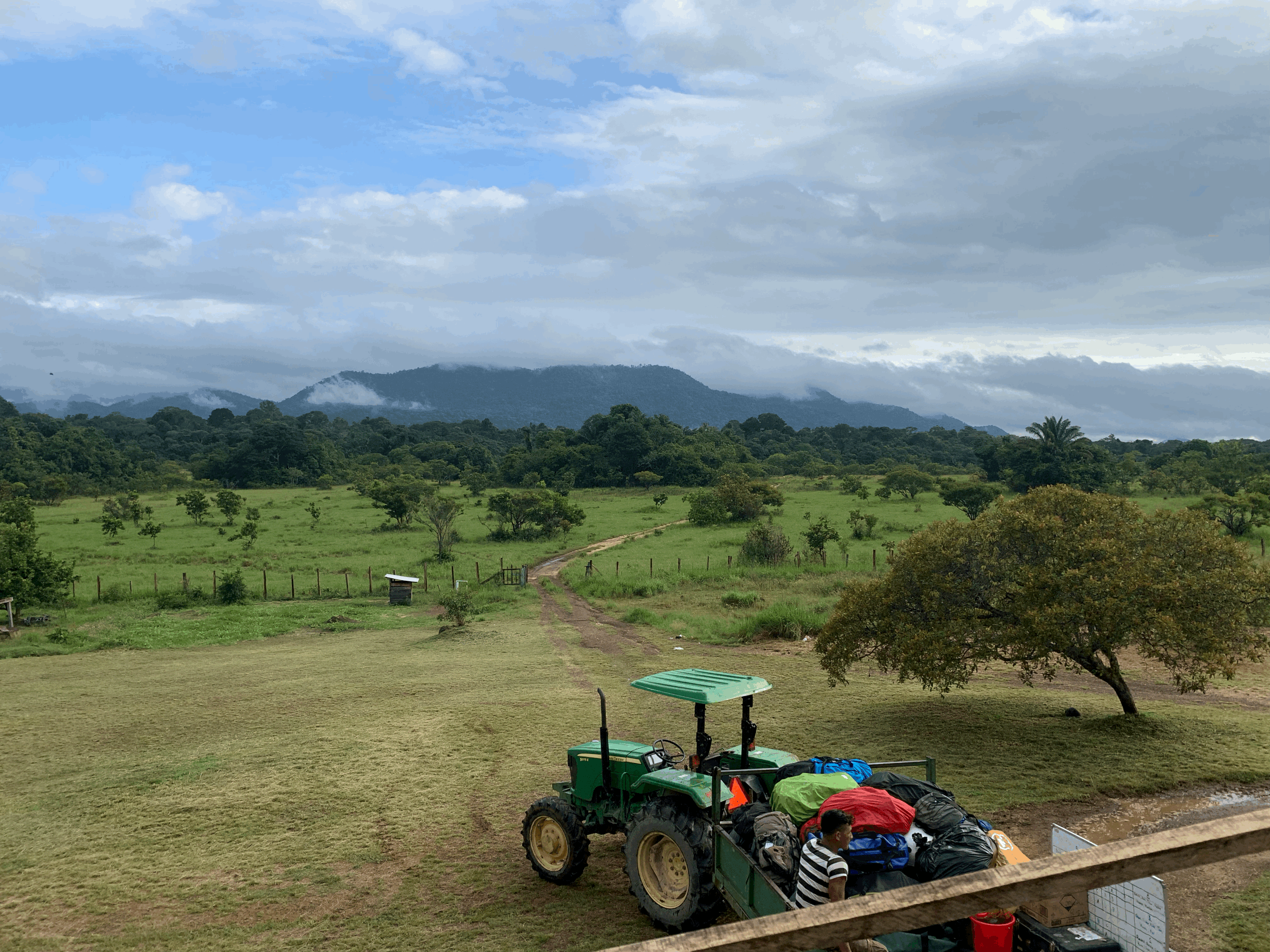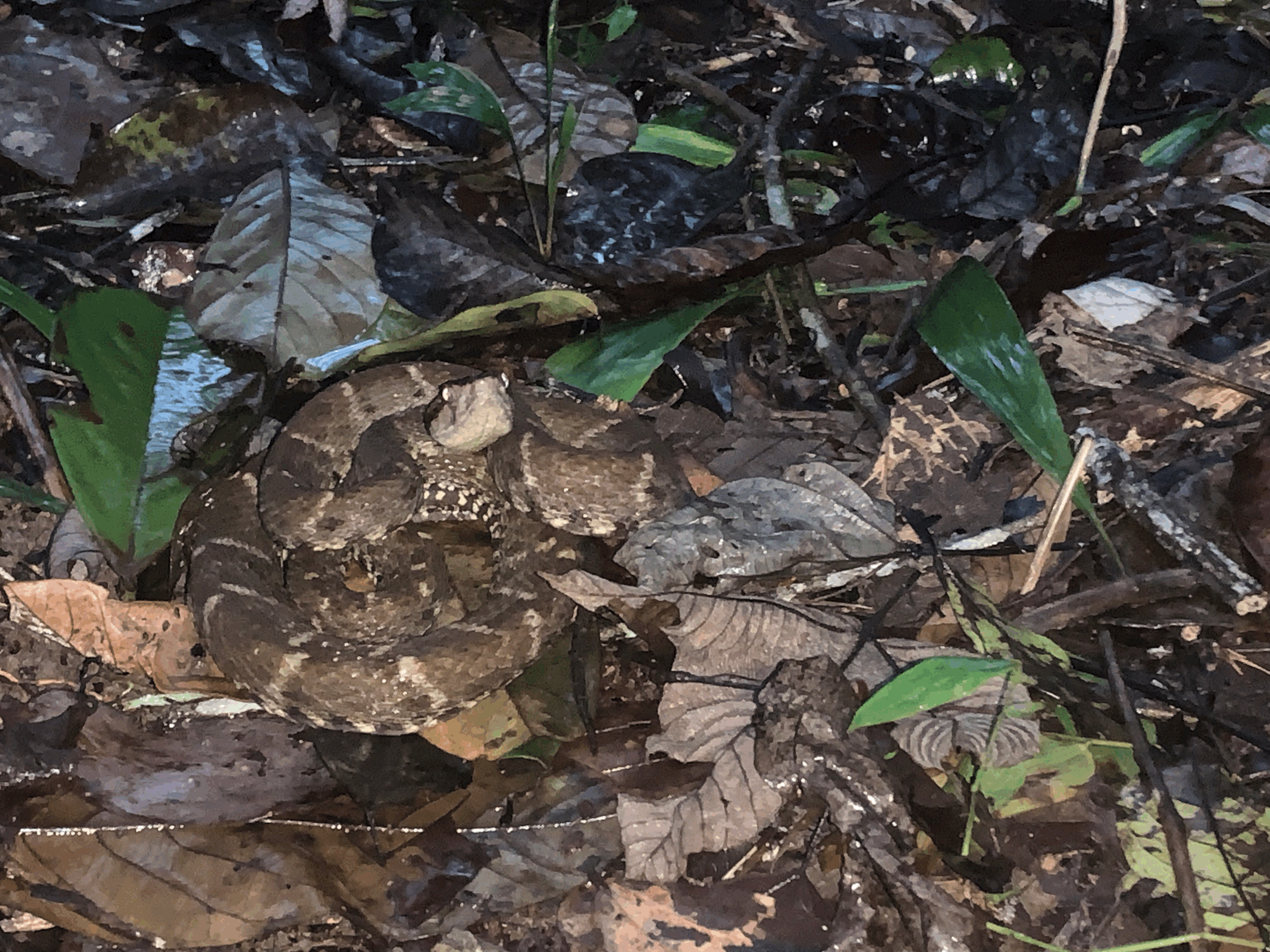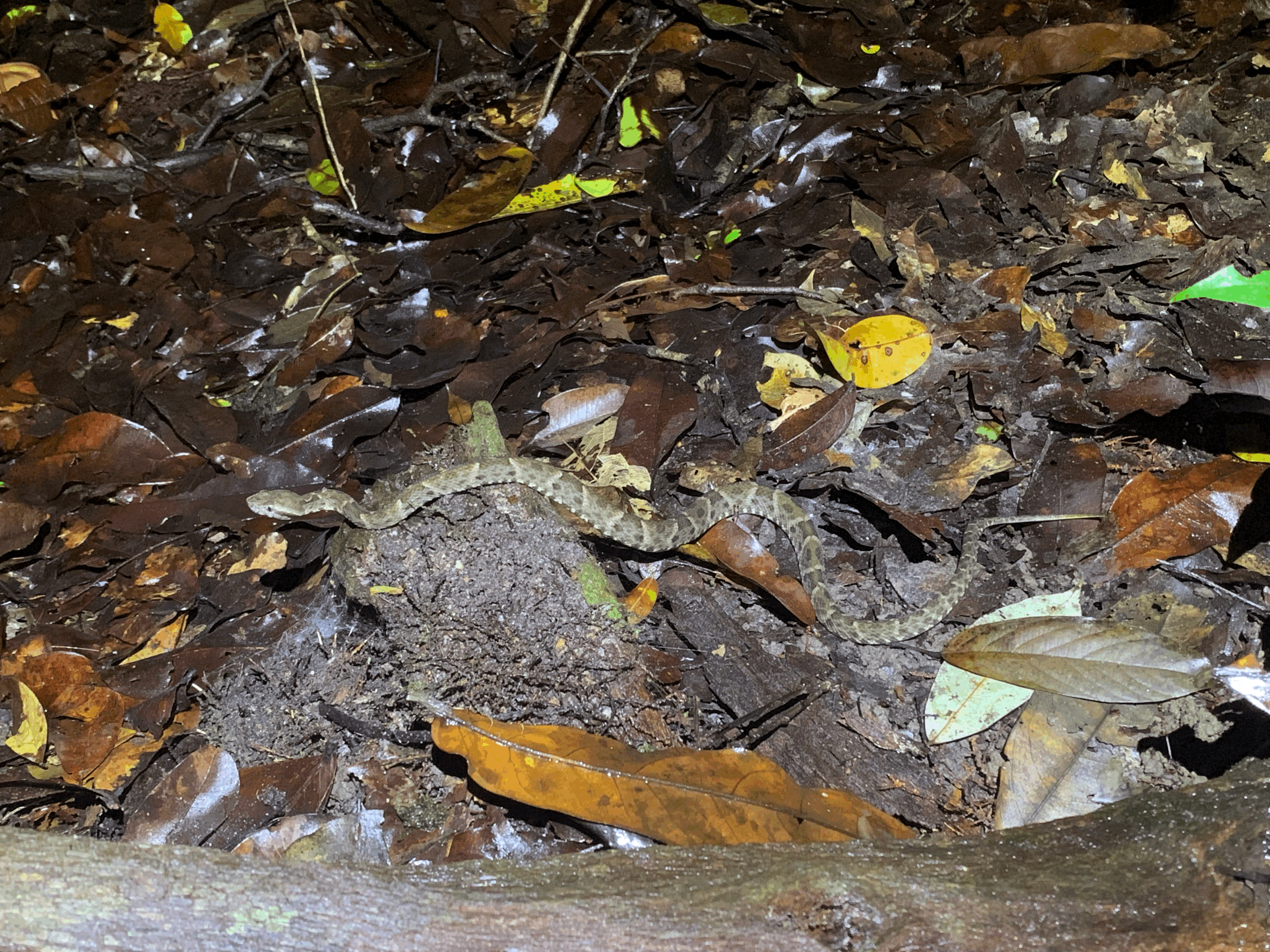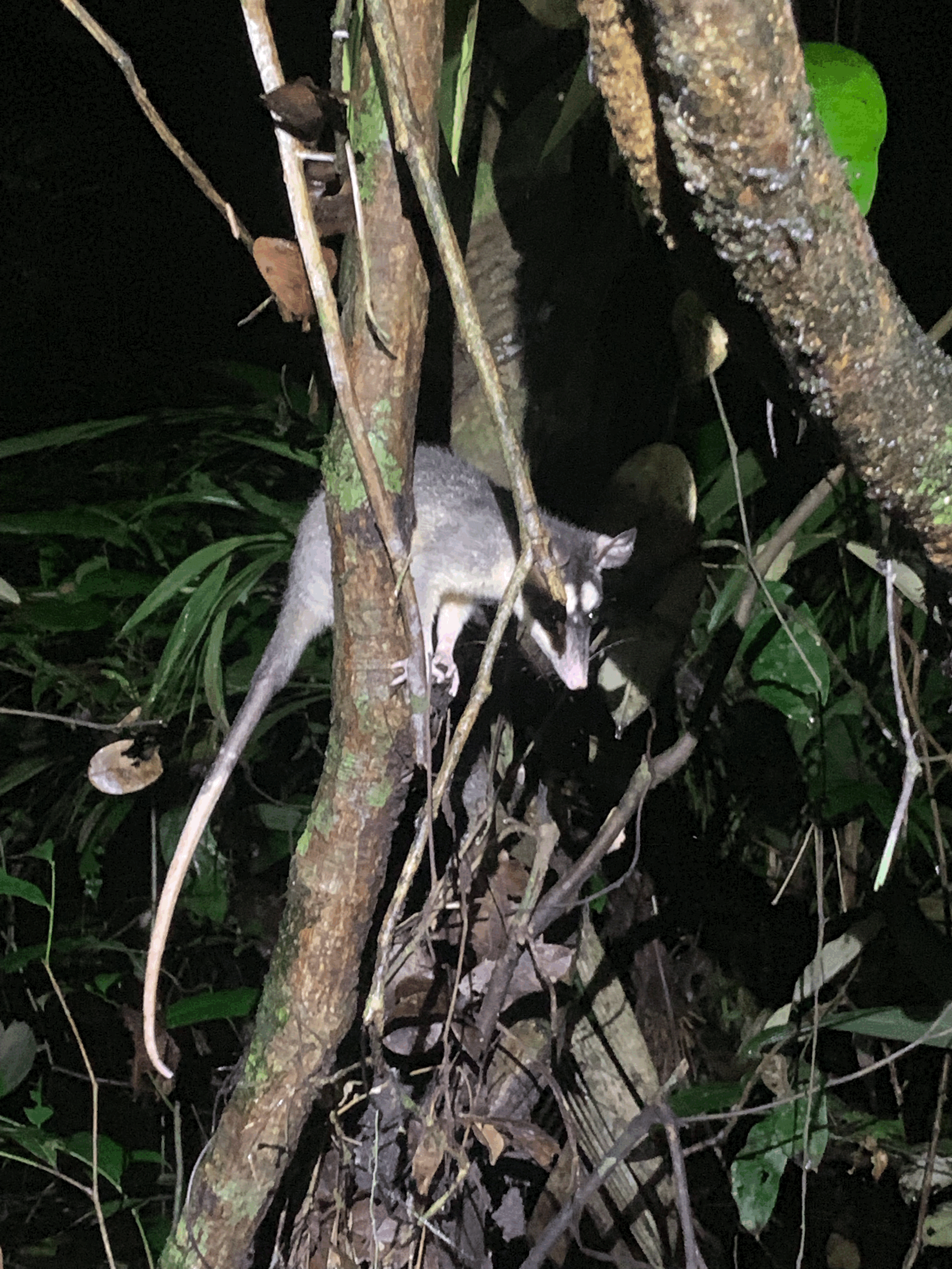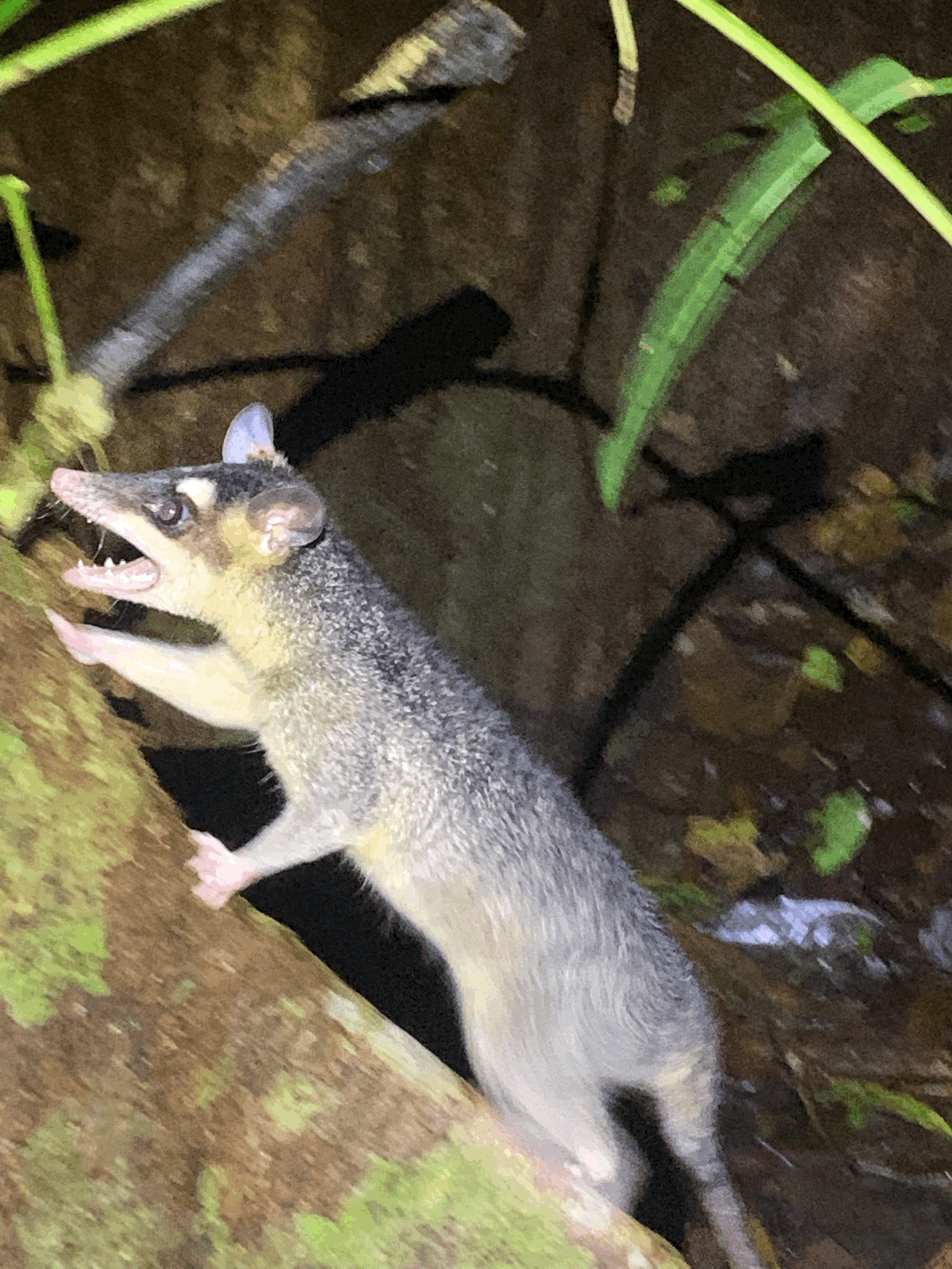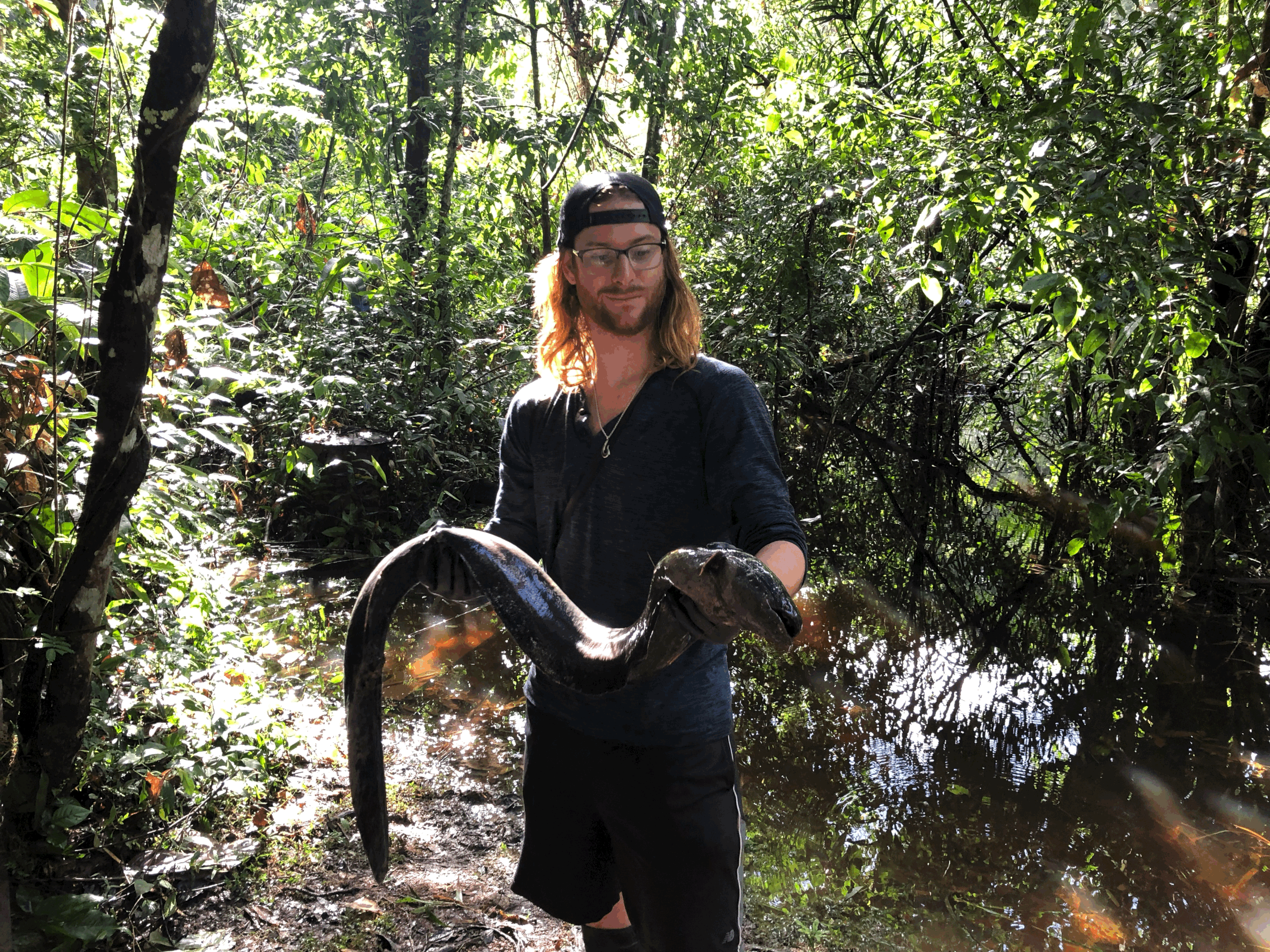The Journey from Surama to Sandstone, Guyana Week 2
Day 8
We wake up super early to head to the south end of the Iwokrama forest, to the village of Surama. This starts as a 3-hour boat ride to the Iwokrama lodge, and we didn’t see anything out of the ordinary. Lots of blue and gold macaws, though. We head to Surama to check a couple of emails and change my gear before heading out to the Sandstone site. We were going to ride in the big military truck, but Sean (mammal Sean) and I opted out for a more comfortable experience (a jam-packed van ride), and it proved worth it. It was about a three-hour ride to the Surama lodge, where we would be staying the night. We saw a red agouti and yellow belly racer on the road to the lodge.
Once we got into the Surama village, I found out that it was actually in South America’s Savannah ecosystem, so it was a pleasure to see this habitat for the first time. We got there just before sunset and had a good forty minutes before the students arrived. We could see a rain shower in the distance covering some of the jungle hills, and it was amazing to observe the savannah habitat.
After the rain shower, a beautiful rainbow and the sun started to paint the clouds with gold and yellow tones. The sun went down, the students arrived, and we got everyone unloaded from the truck. As everyone got settled, I noticed that the fireflies were out and sparkling. The stars also looked amazing, so I decided to take some long exposure shots of the Milky Way and fireflies, and it worked out but I need to do more research on how to get better firefly photos.
I went to bed that night but did not sleep well as there was one dog that had some fleas or other parasites going on and slept right under my hammock. I reckon I also got bit through my mosquito net and got some good lumps on my arm.
Day 9
The way from Surama to Sandstone began with us packing all our stuff up and loading the main bags into a tractor to then hike twenty minutes to the river’s edge to load everything on boats for a five-hour boat ride to the Sandstone site. I was back on a makeshift seat; basically, a plank was positioned diagonally across the boat. It was not the most comfortable ride after an hour, but I am used to situations like this. We saw beautiful birds such as the macaws, toucans, and oropendola (a crow-like bird that makes a wicked cool sound). But the most exciting sighting of the boat journey was the infamous king vulture.
King Vulture
This bird is gorgeous and has amazing color contrast upon its head. The bird was flying very high up, one of the students spotted it, and I got the photo. It was not the best quality, but still a proof shot. After talking with my ornithologist (bird people) colleagues, they told me it was quite a rare sighting, so I was very thrilled about the capture.
We relaxed that afternoon and were excited to hear about the sloth that another boat group saw. That night I went out, and we found a new snake species for me, the white chinned racer. Also found a beautiful small fer de lance that still had the yellow-tipped tail they use for luring. I do not take many photos when I am out in the forest as the environment can take a real toll on your gear. We didn’t find anything too much out of the norm aside from that new snake.
Day 10
Peter (bug man) found some magnificent insects that I photographed the next day. It wasn’t a busy day for me, and I focused on organizing my data sheets and reading a book.
Unicron Katydid
Leaf Katydid
species of butterfly or moths caterpillar stage
Long horn beetle
Assassin Bug
Dung Beetles
That morning I also photographed some birds that the bird team brought back.
Amazon Kingfisher
White Crowned Manakin
But later that evening, while the sun started to get low, Peter (insect dude) spotted a snake slithering near one of the A-frames that all our hammocks are under. It turns out to be a very large fer de lance, so I quickly got my boots on and grabbed my hook. I got the snake into the open, where I could work with it to calm down and realize I am not a threat. After doing that for five minutes, I hooked the snake and carried it up into the forest away from camp, where it would not come in contact with us again. People have very aggressive mindsets about snakes and demonize them. It is wonderful that I can save this remarkable animal to continue with what nature programmed it to do.
Fer De Lance
That evening I went on a herp hike and didn’t find anything too crazy. We did spot two opossum species, fer de lance, chicken frogs, and some geckos.
Fer De Lance
Day 11
I have been keen to get out during the day to hike to see if I can spot any reptiles moving during the day. I went with Sean (mammal Sean) to look for primates and signs of other mammals. Walking along with Sean, we spotted a mother and juvenile spider monkey hanging around five red howler monkeys. The howlers left as soon as we saw them, but the spider monkeys hung around and gave us a marvelous display of behavior that Sean taught us all about. You can tell the sex by the color of the genitalia. We then kept on hiking and looking for stuff: we found tapir tracks and a snakeskin. Right in the middle of the trail was a stunning juvenile yellow foot tortoise that was a joy to see.
Yellow Foot Tortoise
We also found a colossal leafcutter ant nest. It was time to head back to base camp for lunch, but we heard that a guide spotted a mother sloth and baby 50 meters from camp. It was lovely getting to see such an incredible species. She was very high up, and the backlight was making for terrible photos, but I kept checking on her repeatedly and managed to get a good proof photo.
Three Toed Sloth
The guides spotted a Venezuelan sun tiger tarantula, and it was amazing to see that species in the wild. So, I photographed it as it climbed back up its tree.
Suntiger Tarantula
That evening the guides spotted a coral snake slithering in the water, but it was too deep and hard to get to for me to get a hook spring on it. It was amazing to see it.
There was a fishing trip scheduled for the two-week students, and only one student wanted to go, so I decided to join because it is always nice being on a river watching birds and other wildlife move around. We had hand reels and tossed them in the water to get some food for the evening. We had two bites, two giant black piranhas.
Black Piranhas
I set off that evening to find more reptiles for my transects. We did find a leaf toad, paca, and white chinned racer, which were the highlights of that evening.
Day 12
Today was the day that the two-week students would be departing from the project while the rest of us carry on our research. As everyone woke up and were chatting, waiting around for breakfast, the guides all started yelling out “snake” to me, and to my surprise, about five meters from the dining area was an adult pipe snake. This is such a beautiful snake because it mimics the intense color patterns of the more dangerous species of coral snake found here in South America. Coral snakes are the South American continent’s only terrestrial elapids (proteroglyphous or front-fixed fangs). They have tiny eyes because they are a fossorial species and feed under the leaf litter. It was a good send-off for the two-week students to be able to hold this rare species.
Pipesnake
While eating breakfast, we noticed many stingless bees going after everyone’s honey, so I took the leftover droppings of honey and put them on my hand to get the bees to land on me. I got quite a few, for sure. During the day, I crunched in some data and read more of my book. That evening I got out the snake and photographed it. Very tricky species to photograph because they do not sit still. I then processed the snake and let it go where I found it earlier that day. Around lunch time that day I managed to actually catch an Ameiva, which are is a very fast species of lizard.
Ameiva
Later that night, we set off to find the infamous matamata, a leaf-looking turtle that is extremely cryptic and hard to find. It has been found in this area before, so I was very keen on seeing one. Also, in this area is one of the most iconic frogs, the Pipa pipa, otherwise known as the Suriname toad. We started just after dinner and headed toward a trail the guides have made that goes along the edge of the swampy, flooded part of the river. As we made our way to the edge, I immediately spotted a small-sized Pipa pipa. The frogs have a very sensitive nervous system so catching them is complicated bare-handed in deep water. While walking to another edge of the river, I spotted four tiny orange legs poking out of a leaf and realized it was a juvenile pink-toed tarantula. Tree tarantulas tend to have an array of colors during their juvenile stages to ward off predators. I did not have my camera with me, so I’ll go back another day and photograph that cutie.
Sling Tarantula
We continued our search for the matamata and found a couple more juvenile pipa pipas, then a knife fish which is a cousin to the electric eel. Getting to the end of our transects (our planned-out routes), we were coming up with no luck on the turtle, but I heard a commotion on my right and looked over to see one of the guides holding a massive Pipa pipa. I quickly headed over to get a hold of it and admire this fantastic frog. I would take it back for processing as I collect a photo arc for the herpetofauna that I find on this trip for the lead herpetologist before me.
Pipa Pipa
We were walking back to base camp, and out of the corner of my eye, I spotted two glowing white dots, which turned out to be a black-masked opossum who was not in the slightest bit amused at us spotting him. I walked over to get a better look, and its threat display was very intriguing. He would jump on his back legs and hop forward with arms extended and mouth open, hissing. After a couple of theatrical displays, he climbed past us and went on his way. We then made our way back to base camp for the night.
Black Masked Opossum
Day 13
This morning the local guides brought in a bounty of fish which we have been vigorously eating the whole time we have been here. It is honestly some of the best-tasting fish I have ever had. What made this morning more interesting, though, was that the guides brought in a good five-foot-long electric eel that they caught in the net. We took some photos and admired its beauty. The guides, though, use the eel for bait, and the eel, unfortunately, was turned into bait.
Electric Eel
Today was a very relaxing day for me, and my main goal was to get photos of the Pipa pipa. It was weird waking up with only half of our group now that the two-week students had left. Still, the jungle and camp were as noisy as ever in the early morning so sleeping in for me is impossible. I caught up on the book I was reading and caught up on this journal. While filming with the frog, a group of wedge-capped capuchins came crashing through the canopy overhead, maybe five or seven of them.That would be my third species of primate while being in Guyana! I then released the frog where we found it.
Pipa pipa
I also wanted some photos of the tarantula, but underneath the leaves, the army ants were on the full move, and you do not want to stand in their path because, holy crap, their bites hurt. Unfortunately, that day mammal Sean had to leave for a couple of days as he was feeling feverish and was worried that he had contracted Dengue, but it turned out to be just a fever.
We were moving to the Surama village to then head out the next day to Canopy Walkway. That night our transect was going to be on the river, and we headed out after dinner with a group of the staff as they have not been out on a night river survey yet. It started very slow spotting animals because of the most irritating animal for me, a moth that has the bright red eyeshine like a tree boa, frog, or caiman has. After being juked by many moths, we were all keen on finding something serious. We did spot a cool bird high up in the forest, which I thought was an owl at first glance, but Vanessa (bird person) quickly ID’d it as the great potoo.
We then kept going on our way, and the guide and I spotted that little yellow eye, which I immediately knew was a snake. It turned out to be a beautiful juvenile amazon tree boa with quite the attitude while pulling it off the branch. At that size, though, you don’t feel the bite. Bagging the snake to photograph and process later, we continued our search for eyeshine.
Amazon Tree Boa
We then spotted a big beauty, Boana geographica, which I haven’t seen yet. Such a unique species of frog. We then spotted a very rare species of heron (the Agami), which from hearing how excited the birders were, was not common around this area at this time of year. Beautiful bird, for sure. We headed back to camp for the night, still searching for that very elusive emerald tree boa, my ultimate target, along with the green anaconda.
Day 14
Today was our last day at Sandstone. The bat and bird team set off to pack up their equipment while I processed the snake from the previous night and then did a photo session with it for the students to show them how to photograph snakes using the correct camera settings and such. We also got a very beautiful katydid species with fantastic texture and contrast. I finished the fiction book about the Amazon I was reading. I typically like to get a book about each area that I’m going to be in.
Thorny Katydid
We set out that night to look for the mata mata turtle again but no luck. I did, however, find a pair of Pipa pipa which was awesome to see, but these two were very skittish, and I wasn’t able to get a photo. We then searched and found some astounding arachnids, especially a pink-toed tarantula, which had dropped onto Shane’s (technician man) head. We ended up spotting a massive rat species and a paca. A red vine snake was cool to see because I haven’t seen them after the first night in Cabokali. The rain started to hit, so we quickly made our way back to camp to pack up to leave the next day.


